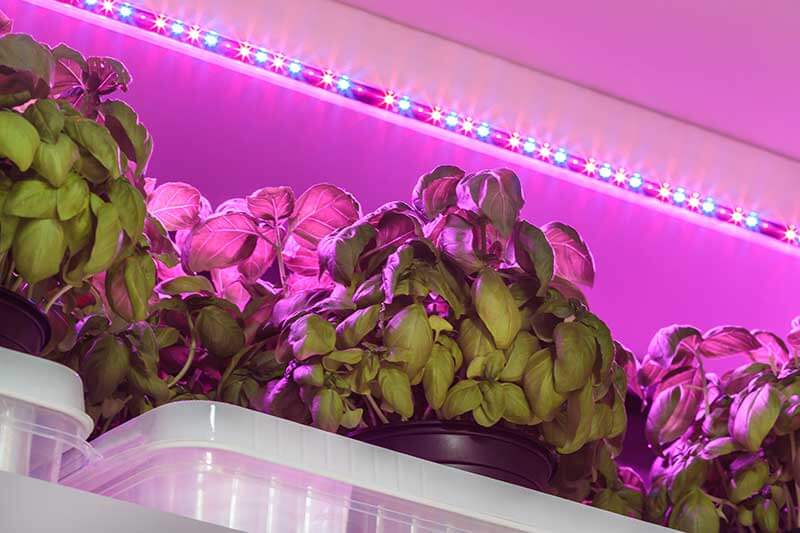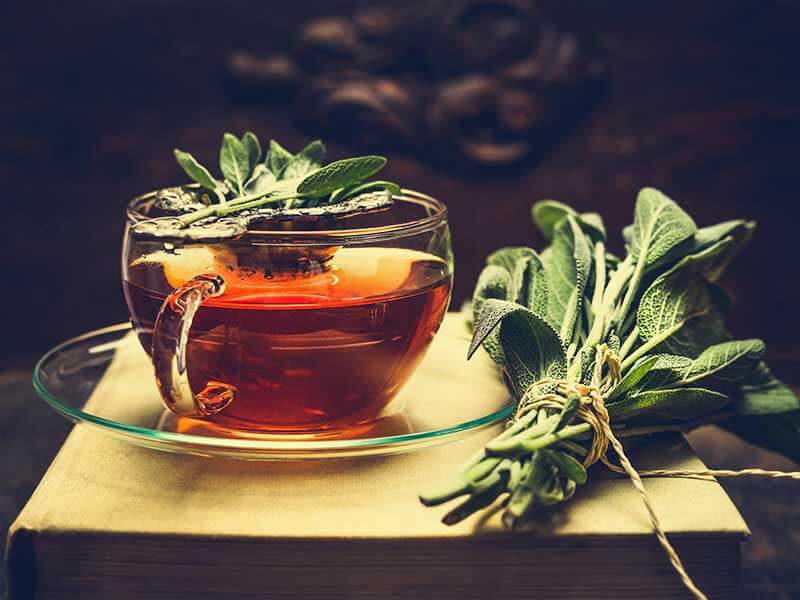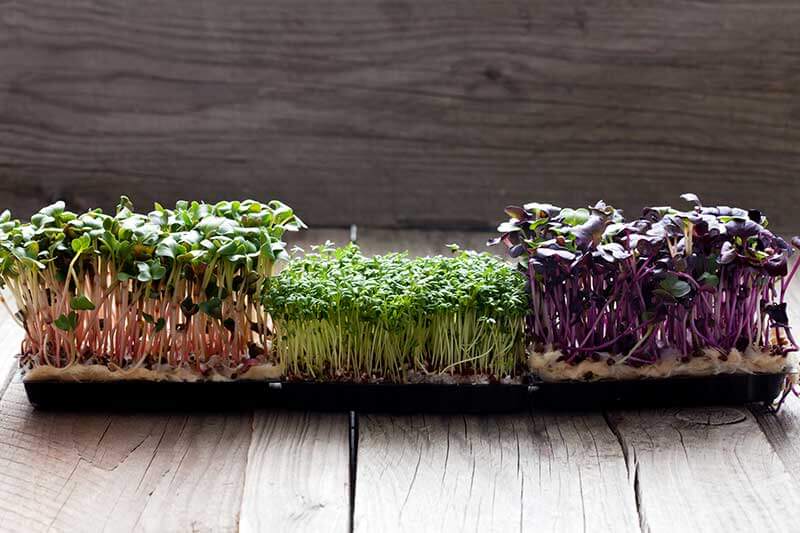How to Grow Flowers, Herbs and Vegetables Indoors
During the winter months, as outdoor gardens and flower beds sit dormant, many gardeners truly miss tending to and nurturing their plants. But an indoor garden can exercise your green thumb all year long — and liven up your home, too. It's especially satisfying to nurture and harvest edible plants indoors during winter's chill, and if you've got children, it's a fun way to introduce them to the joys of gardening.
Whether you devote one windowsill or a whole room to your indoor garden, you'll find that there's an abundance of edible flowering plants, herbs and even vegetables that do well in containers. Most only need the filtered light of a south-facing window to thrive, although you can always maximize your harvests by using grow lights. Many grow lights are energy efficient and provide an unobtrusive, and even welcoming, glow to your garden area.1

Increase your indoor garden yields by using grow lights.
Flowers
Edible flowers add cheerful splashes of color to your indoor garden and make for delicious, soothing teas or lively additions to salads and desserts. The North Carolina Cooperative Extension Service has a fantastic list of edible flowers to introduce to your menu.2 Here are a few to get you started:
- Nasturtiums. These vibrant flowers are easy to grow in well-drained soil near a sunny window. Both the leaves and blossoms have an impressive peppery flavor and are high in Vitamin C.3 Nasturtiums come in many colors and varieties, from compact cultivars to gentle trellising types.4 Experiment with several varieties to discover your favorites.
- Hibiscus. The blooms of hibiscus plants are eye-catching and beneficial. Tea made from hibiscus has anti-inflammatory properties and has been used throughout history for its medicinal value.5 There are many varieties to choose from, but Hibiscus sabdariffa is the most commonly grown for making tea, syrup and preserves.
- Violets. Sweet violets (Viola odorata) and garden pansies are culinary favorites. Their delicate, aromatic blooms enhance a variety of drinks and desserts. The blossoms can also be candied for a special treat.6 These plants don't want a lot of heat; a temperate place near a sunny window will do.
The first step to growing healthy plants is to provide them with nutrients. Earthworm castings blended into your potting mix will help aerate the soil and prevent nutrients from leaching away during watering. To help promote root growth, add Alaska Morbloom Fertilizer 0-10-10 once a month.


Violets liven up salads, desserts and drinks.
Herbs
Many herbs, if pruned gently without disturbing the roots, will replenish themselves for a continuous supply of goodness. Use fresh herbs in your recipes, dry them for use later, or use them in either form to make long-lasting herbal vinegar and oils. Nearly all herb plants can be cultivated indoors, so don't be shy about experimenting with different varieties. Start with these must-haves:
- Chives. When trimmed frequently, chives regrow as you harvest. But let some bloom to enjoy their beautiful lavender blossoms, which are also edible. Chives also tend to repel aphids, so intermingle them among the other plants in your garden to deter those sap-sucking insect pests.7
- Sage. Sage plants provide your garden space with interesting textures, hues and aromas. Garden sage goes well with sausage dishes, beans, sauces and stuffing. Pineapple sage is a favorite for drinks and jams. Rich in folic acid and vitamin C, sage leaves can be dried and used to make immune-boosting tea.8
- Parsley. This deep green herb is loaded with beta-carotene, iron and vitamin K. It also has tummy-soothing properties and can help relieve indigestion.9 Chewing on a few parsley sprigs is a quick, healthy way to freshen your breath. Enjoy in soups, salads, herbal butters and cheese spreads.
Whether you grow herbs from seed, cuttings or nursery plants, use Pennington Plant Starter to aid in root growth and reduce transplant shock. Provide rich nutrients and organic matter by adding Alaska Fish Fertilizer 5-1-1 every 3 to 4 weeks.
Teas made from sage are aromatic, flavorful and medicinal.
Vegetables
Most cool-weather vegetables can be grown indoors. A south-facing window will provide enough sunlight to keep them growing, though a low-temperature grow light will greatly increase your yields. The following are easy to grow, quick to harvest and require minimal space:
- Carrots, Beets and Radishes. These and many other root veggies can be started from seed or by using the toothpick method: Using toothpicks, suspend a cutting of a "stem and stump" in a shallow glass of water until it grows roots. Then transfer to a deep pot with loose, rich soil.10 Switch up varieties to keep a constant supply of these nutrient-dense root vegetables on hand. Heirloom varieties of each are available in a mixture of colors, shapes and textures that will delight you and your dinner guests.
- Salad Greens. Romaine lettuce, arugula, kale, spinach, turnip greens, celery and broccoli are just a few of the salad greens you can grow indoors. Mix and match varieties to keep your menu interesting. Harvest outer leaves first to encourage continued plant growth.
When growing vegetables to eat, be sure to get quality plants or seeds from reputable sources. To promote flavorful veggies, treat with Alaska Fish Fertilizer 5-1-1.as directed.

Propagate radishes and other root vegetables by suspending them in a glass of water to take root.
Hints & Tips
- Choose a variety of plants and intermingle them. This will make an interesting display as well as increase the humidity level as water evaporates from plant leaves. Lightly mist with a spray bottle several times a week.
- Treat your plants to earthworm casting tea every 6 weeks to significantly increase growth and yields.
- Plant or propagate additional plants in late winter to transplant to your outdoor garden or raised beds in the spring.
- Grow a patch of micro-greens from seeds for a delicious batch of concentrated nutrients.11 Place one inch of soil in a shallow tray and smooth out evenly. Sprinkle seeds and cover with a thin layer of soil. In about two weeks, or when your sprouts are two inches tall, your greens will be ready to harvest. Just cut with scissors and enjoy. Beets, radishes, clover, spinach and herbs work well for this endeavor.
Once you've succeed with your first edible garden indoors, experiment with other edible plants, such as avocados, turmeric, strawberries, lemons, and even mushrooms. As you discover which plants are best suited to your home and your taste buds, you'll find that the sky—or, rather, the ceiling — is the limit!

Immature leafy vegetables, herbs and edible flowers can be grown and harvested as nutrient-dense micro greens.
Pennington is a registered trademark of Pennington Seed, Inc. and Alaska are registered trademarks of Central Garden & Pet Company.
References
1. Zachos, Ellen & Wiley, Deb, "Plant Grow Lights: Which Kind to Choose," Better Homes & Gardens
2. "Choosing and Using Edible Flowers," North Carolina Cooperative Extension Service, October 2014.
3. Cook, Donna, "Not just pretty, edible flowers pack nutritional punch," The Kansas City Star, September 3, 2013
4. "Durable, Delectable Nasturtiums," The National Gardening Association, Learning Library Plant Database, June 23, 2008
5. Branch, Solomon, "What Are the Health Benefits of Hibiscus Tea?," Livestrong.com, Livestrong Foundation, January 8, 2014
6. "How To Choose Edible Flowers – Edible Flower Chart," What's Cooking America
7. Oder, Tom, "12 plants that repel unwanted insects," Mother Nature Network, October 2, 2014
8. Roizman, Tracey, "What Is Sage Tea Good For?," SFGate, Healthy Eating
9. Krishan, Shubhra and Striepe, Becky, "7 Surprising Parsley Health Benefits (And How to Eat More of It)," Care 2
10. Boyles, Margaret, "Grow an Indoor Salad Garden from Stumps, Stems and Roots," The Old Farmer's Almanac
11. Galloway, Willi Evans, "Microgreens—The Salad You Can Grow Inside," Rodale's Organic Life, November 18, 2015



